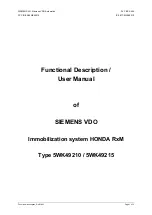
Battery-Powered Single
Station Smoke Alarm
Owner’
s Manual
110-1011E
Thank you for purchasing a Firex
®
smoke alarm. It is an important
component of your home security system. Please read this booklet
thoroughly. The more familiar you are with the information it
contains, the easier you will find it to install, operate, and
maintain your smoke alarm properly, which ultimately means
greater security and peace of mind for you and your family.
Invensys Controls Americas
1 Smoke Alarm Features
2 Proper Placement of Your Smoke Alarm
3 Additional Smoke Alarm Placement Information
3 How to Install Your Smoke Alarm
3 Testing Your Smoke Alarm
4 LED Power/Alarm Indicator
4 Special Features of Model CC, CEC, CCPB and CPBC
4 Maintenance and Cleaning
5 Troubleshooting
5 Important Safety Information
5 Limited Warranty
6 Home Fire Safety Tips and Procedures
Table Of Contents
CB, CC,
CEC–Ionization-type,
CCPB Dual Sensor
Photoelectric /
Ionization-type,
CPBC–Photoelectric-type
sensor
Smoke Alarm Features
• Models CB, CC and CEC are ionization-type smoke alarms.
• Model CCPB is a dual sensor photoelectric / ionization-type smoke alarm.
• Model CPBC is a photoelectric-type smoke alarm.
• Unique “battery missing” feature. The smoke alarm will not attach to the mounting bracket if a battery
is not in the battery pocket.
• Low battery signal. The smoke alarm will sound a short beep about once a minute if the battery
needs replacement.
• Optional tamper-resist feature can serve as a safeguard against tampering.
• Visual LED flashes about once a minute. This indicates the smoke alarm is receiving power.
• Loud alarm horn—85 decibels at 10 feet—sounds to alert you of an emergency.
• Test button checks smoke alarm operation. Model CC, CEC, CCPB and CPBC features Alarm Control
(Quick-Quiet
™
). When activated, this quiets unwanted alarms for a maximum of 15 minutes.
• Model CEC features the Safety Light. This is a small light which will turn on when the smoke alarm
sounds its alarm horn, illuminating emergency exits.
The ionization type alarms are generally more effective at detecting fast, flaming fires which
consume combustible materials rapidly and spread quickly. Sources of these fires may
include flammable liquids or paper burning in a waste container. The photoelectric type
alarms are generally more effective at detecting slow, smoldering fires which smolder for
hours before bursting into flame. Sources of these fires may include cigarettes burning in
couches or bedding. However, both types of alarms are designed to provide adequate
detection of both types of fires. If you desire the benefits of both systems, you should
install smoke alarms that combine in one alarm both photoelectric and ionization sensing
technologies.
S
T
A
TE
OF
CALIF
O
R
N
IA
S
T
A
T
E
FIRE MAR
S
H
A
L
L
I S
T I N
G
S
E
R V I C
E
110-1011E English 12/12/06 10:10 AM Page 1
























